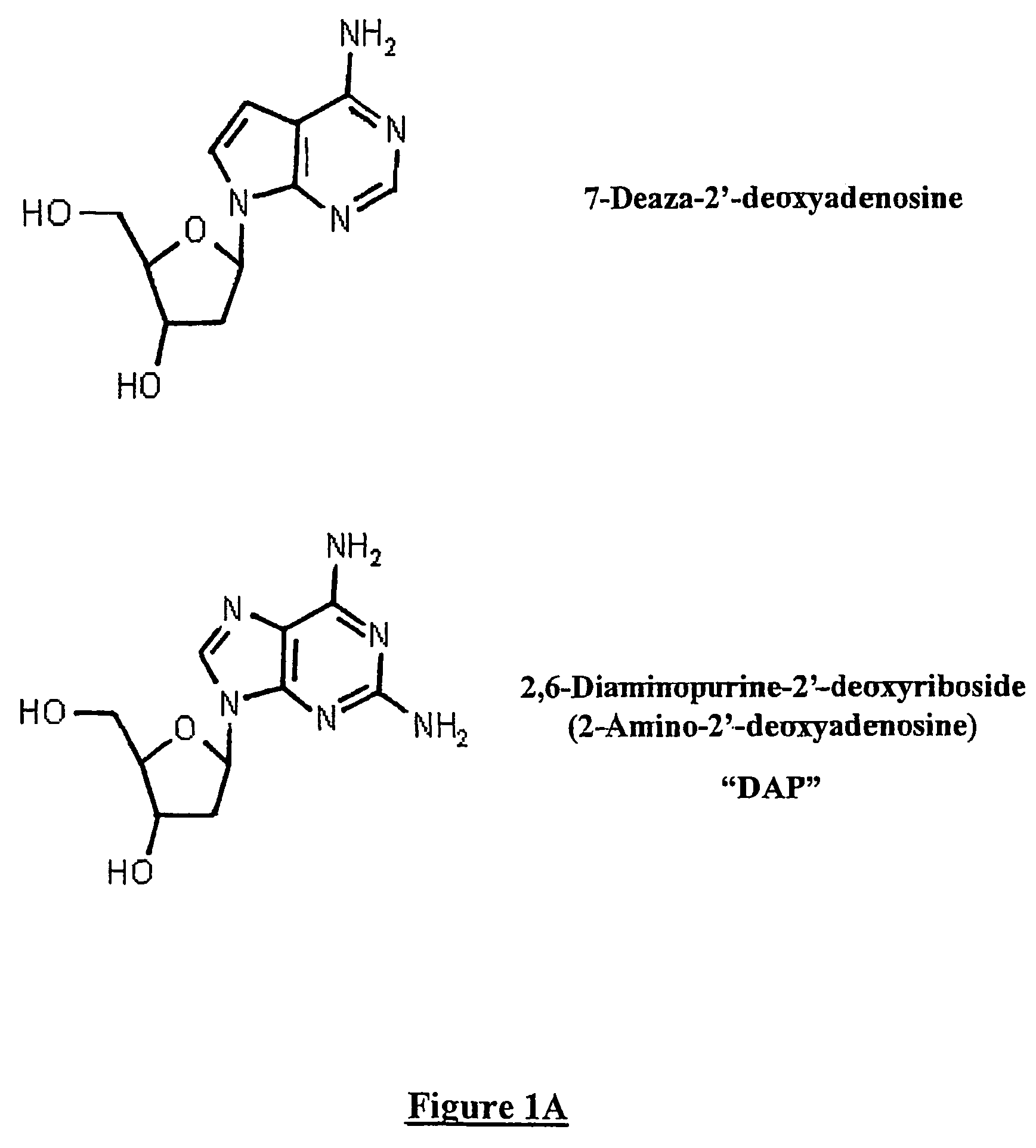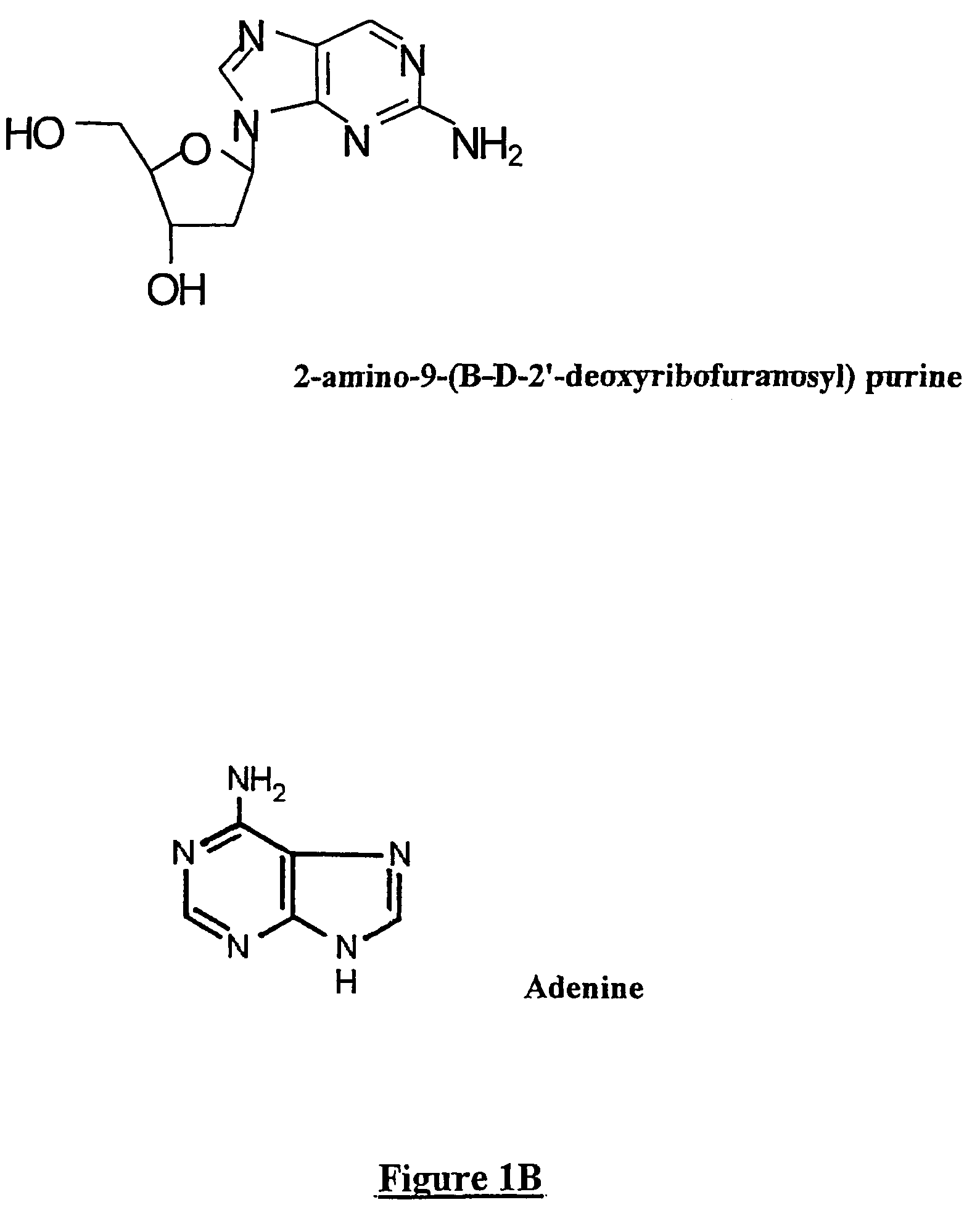Methods for increasing in vivo efficacy of oligonucleotides and inhibiting inflammation in mammals
a technology of oligonucleotide and in vivo efficacy, which is applied in the direction of immunological disorders, drug compositions, peptide/protein ingredients, etc., can solve the problems of inability to systematically test whether the replacement of bases by analogs could affect stability, binding, degradation efficacy and toxicity, and achieve the effects of inhibiting eosinophil influx, increasing lung resistance, and inhibiting eosinophil influx
- Summary
- Abstract
- Description
- Claims
- Application Information
AI Technical Summary
Benefits of technology
Problems solved by technology
Method used
Image
Examples
example 1
Replacing Adenosine by DAP is at Least as Effective In Vitro as a Regular Phosphorothioate Antisense Oligonucleotide
[0081]A first set of experiments was designed in order to determine whether replacement of adenosine by DAP affected the in vitro efficacy of AS oligonucleotides. It is to be noted in FIG. 2A that the biological effectiveness of antisense to the common Beta chain of human GM-CSF, IL-3 and IL-5 receptor is not affected by replacing adenosine by 2-amino-2′deoxyadenosine in U937 cells that express this receptor. AS107 is a 19 mer oligonucleotide that contains 2 adenosine bases. The adenosine bases were replaced by DAP (AS107-DAP). This modified oligonucleotide was at least equally effective at blocking the mRNA for the common Beta chain when assessed by semi-quantitative PCR (with G3PDH as a housekeeping gene) as AS107 containing adenosine (AS 107).
[0082]To confirm the efficacy in another cell line, experiments were repeated in TF1 cells that are dependent on GM-CSF for t...
example 2
Not all Substitutes of Adenosine are Effective at Inhibiting Genes when Incorporated into Phosphorothioate Antisense Oligonucleotides
[0083]Experiments were performed in order to determine whether substituting adenosine would affect the efficacy of antisense oligonucleotides. It is to be noted in FIG. 3 that the effectiveness of the same antisense oligonucleotide as described above (AS107) is lost when both adenosines are replaced by inosine. Antisenses containing inosine (AS107-I) was not effective at inhibiting mRNA expression when assessed by semi-quantitative PCR and compared to AS107 containing adenosine. Experiments were performed by incubating U937 cells with medium alone, AS107 or AS107-I at a concentration of 10 μmol for six hours prior to isolating RNA and performing semi-quantitative PCR.
example 3
An Increase in Lung Resistance Occurs after Intratracheal Injection of Phosphorothioate Antisense Oligonucleotides that is not Related to Adenosine
[0084]Experiments were performed to assess the effect on lung resistance after rapid intratracheal injection of phosphorothioate antisense oligonucleotides contained in 50 μl of saline.
[0085]FIG. 4A illustrates the effects of intratracheal administration of an antisense phosphorothioate oligonucleotide directed against the common Beta chain of rat GM-CSF, IL-3 and IL-5 (AS141, a 19 mer oligonucleotide that contains 2 adenosines) and the effect of a DAP-substituted phosphorothioate antisense oligonucleotide (AS141-DAP) of the same sequence, at a dose of 60 μg each, on lung resistance of sensitized Brown Norway (BN) rats. For these experiments and the following, sensitized Brown Norway rats were employed as previously described (Renzi P M, Am Rev Respir Dis 146:163-9; 1992). The injection of phosphate buffered saline caused a mild increase ...
PUM
| Property | Measurement | Unit |
|---|---|---|
| length | aaaaa | aaaaa |
| volume | aaaaa | aaaaa |
| concentration | aaaaa | aaaaa |
Abstract
Description
Claims
Application Information
 Login to View More
Login to View More - R&D
- Intellectual Property
- Life Sciences
- Materials
- Tech Scout
- Unparalleled Data Quality
- Higher Quality Content
- 60% Fewer Hallucinations
Browse by: Latest US Patents, China's latest patents, Technical Efficacy Thesaurus, Application Domain, Technology Topic, Popular Technical Reports.
© 2025 PatSnap. All rights reserved.Legal|Privacy policy|Modern Slavery Act Transparency Statement|Sitemap|About US| Contact US: help@patsnap.com



